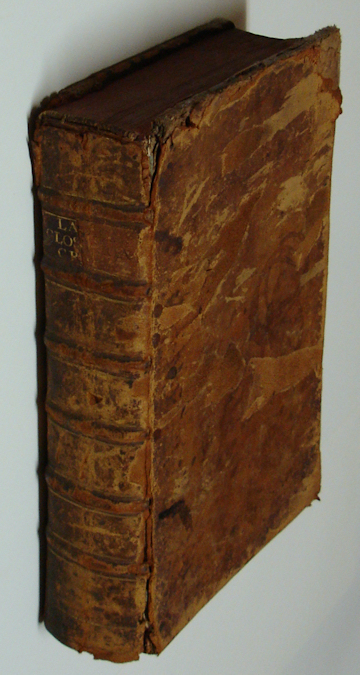LABBAEUS,C. (Ed.)
Cyrilli, Philoxeni aliorumque veterum Glossaria latino-graeca, & graeco-latina, a Carolo Labbaeo collecta & in duplicem alphabeticum ordinem redacta. Cum variis emendationibus ex MSS. Codd. petitis, virorumque doctorum castigationibus ac conjectaneis, his accedunt Glossae aliquot aliae latino-graecae ex iisdem Codd. MSS. quae nunc primum prodeunt. Praeterea veteres glossae verborum juris, quae passim in Basilicis reperiuntur, ex variis perinde Codd. MSS. Bibliothecae Regiae erutae, digestae, & notis illustratae ab eodem Carolo Labbaeo. (Edidit et praefationem adjecit Car. Du Fresne du Cange) (
Bound with:) (Aegidius Bucherius) Aegidii Bucherii Atrebatis e Societate Iesu De doctrina temporum commentarius in Victorium Aquitanum, nunc primum post 1177 annos in lucem editum, aliosque antiquos Canonum Paschalium Scriptores, chronologiae Ecclesiasticae illustrandae ac stabiliendae utilissimos.
Ad 1: Paris (Lutetiae Parisiorum), Cura & impensis Ludovici Billaine, 1679. Ad 2: Antwerp (Antverpiae), Ex officina Plantiniana Balthasaris Moreti, 1634. (Colophon at the end: 'Antverpiae, Ex officina Plantiniana Balthasaris Moreti, 1633')
Folio. 2 volumes in 1: (II),208,(2),246 (recte 244);40 p.; (XXXII),500,(2 colophon & printer's mark) p. Contemporary calf. 33 cm (
Ref: Ad 1: Hoffmann 1,497; Brunet 2,464; Ebert 5608; Graesse 2,317. Ad 2: STCV:6667622; Beledimar 1921: Ebert 2098b, who gives as date 1633; Backer-Sommervogel I, 1867, 2, who mentions the date 1636) (
Details: Back with 6 raised bands.
Ad 1: This collection of 'glossaria' consists of 3 parts, the first two of which have their own title page, each showing a woodcut ornament. The first part contains the Greek-Latin 'glossaria', the second part the Latin-Greek 'glossaria'. The third part, the last 40 p., contain the 'Veteres Glossae verborum juris'.
Ad 2: Title in red & black. An engraving of angels around the Jesuit IHS-device on the title. Plantin's printers' mark on the verso of the last leaf) (
Condition: Binding very worn & very shabby. Leather on the boards abraded. Head & tail of the back chafed. Shield on the back half gone. Corners bumped. Front hinge cracking, but strong. Fold in the front flyleaf. Margins of the first title are thumbed and browning. A few not objectional wormholes in the upper & lower margin, keeping far away from any text) (
Note: Ad 1: Philoxenus Alexandrinus was a grammarian who lived in the first century BC. Traces of his work are to be found in later grammarians and lexicographers. (Neue Pauly, Philoxenus 8)
§ Cyrillus, 5th century AD. His Glosses were used by Hesychius, Photius and in the Suda. (Neue Pauly, Kyrillos 5 and 6).
§ Charles Labbé, 1582-1657, was a parliamentary barrister at Paris, who published, with the help of J.J. Scaliger Glosses on Greek law (1607), and prepared an edition, this edition, of the Glossaries of Cyril and Philoxenus, which was published after his death by the French philologist, lexicographer and historian of the Middle Ages and Byzantium, Charles du Fresne, sieur du Cange, in short Du Cange (1679). (Sandys 2,287) The first part of this work contains Greek-Latin glosses, the second Latin-Greek glosses, followed by emendations. This work was reprinted in London, 1817, etc. as an appendage to the new edition of Stephanus' Greek Thesaurus.
Ad 2: Aegidius Bucherius (Gilles Boucher), 1576-1665, was a French Jesuit and chronological scholar. His 'De Doctrina Temporum commentarius in Victorium Aquitanum' of 1633/34 published for the first time a number of important medieval chronological documents, and other works on the computation of the date of Easter (the so-called cycle of Victorius of Aquitaine). First comes the 'Canon Paschalis' of Victorius Aquitanus himself, followed by Bucherius' commentary (p. 1-288), then comes bishop Hippolytus Portuensis' (of Portus, also known as Hippolytus of Rome) 'Canon Paschalis priscorum Latinorum rationibus confirmis', also with the commentary of Bucherius (p. 289-312), then Bucherius' treatise 'Tractatus de antiquo Paschali Iudaeorum cyclo latinorum item conformi, maxime ex Epiphanio' (p.313-432), and the 'editio princeps' of Anatolius Alexandrinus' 'Canon Paschalis' (433-466), and finally the 'Epistolae patrum antiquorum de festi Paschalis ratione' (p. 467-493).
§ Victorius Aquitanus had written ca. 450 the 'Cursus Paschalis', called 'Canon Paschalis' in this edition, in which he introduced a more precise computation of Easter. During the Synode of Orléans of 541 Victorius' computations were accepted by the church. (LMA 8,1629/30). Bucherius tells us in the 'praefatio' that he got the MS with the 'Cursus Paschalis' from his fellow Jesuit Jacobus Sirmundus during a visit to Paris in 1615. The 'editio princeps' of and the commentary on the 'Cursus Paschalis' and of the other late antique and early medieval computistical texts laid, together with the work of Joseph Justus Scaliger (1579 and 1606) and that of Dionysius Petavius (1627), the foundations of the science of 'Computus', the science of time-reckoning, and of 'Computus ecclesiasticus', the method to regulate the calender of the church, especially the date of Easter) (
Collation: Ad 1: pi1; A-2C4; chi1, A-2A4, 2B2, 2C-2H4; a-e4. Ad 2: *- 4*4, A-3R4 (minus blank leaf 3R4)) (Photographs on request) (Heavy book, may require extra shipping costs)
Book number: 027616 Euro 725.00
Keywords: (Oude Druk), (Rare Books), Bucherius, Cyrillus, Du Cange, Eastern, Labbaeus, Labbé, Lexikographie, Lexikon, Ostern, Philoxenus, computus, cursus pachalis, editio princeps, lexicography, lexicon
 LABBAEUS,C. (Ed.)
LABBAEUS,C. (Ed.)

